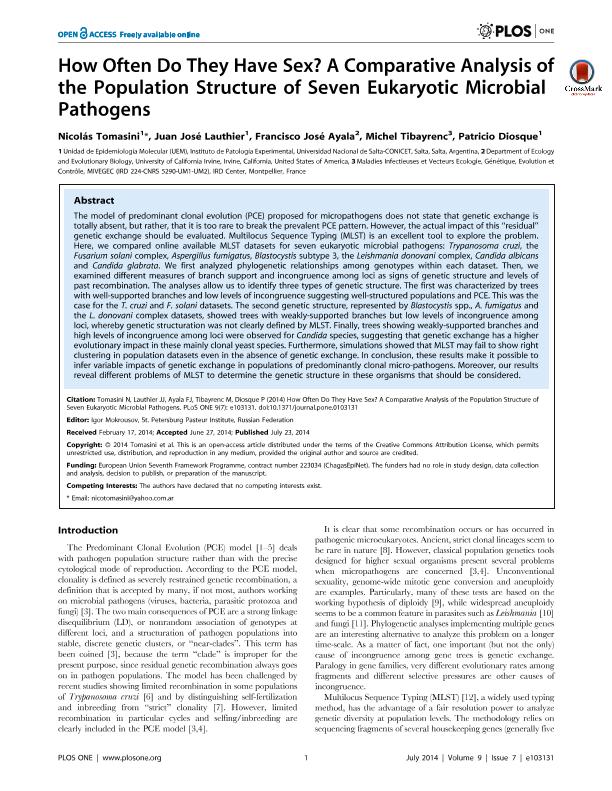Mostrar el registro sencillo del ítem
dc.contributor.author
Tomasini, Nicolás

dc.contributor.author
Lauthier, Juan José

dc.contributor.author
Ayala, Francisco Jose
dc.contributor.author
Tibayrenc, Michel
dc.contributor.author
Diosque, Patricio

dc.date.available
2016-08-08T15:09:59Z
dc.date.issued
2014-07-23
dc.identifier.citation
Tomasini, Nicolás; Lauthier, Juan José; Ayala, Francisco Jose; Tibayrenc, Michel; Diosque, Patricio; How often do they have sex? A comparative analysis of the population structure of seven eukaryotic microbial pathogens; Public Library Of Science; Plos One; 9; 7; 23-7-2014; 103131-103131
dc.identifier.issn
1932-6203
dc.identifier.uri
http://hdl.handle.net/11336/6982
dc.description.abstract
The model of predominant clonal evolution (PCE) proposed for micropathogens does not state that genetic exchange is totally absent, but rather, that it is too rare to break the prevalent PCE pattern. However, the actual impact of this "residual" genetic exchange should be evaluated. Multilocus Sequence Typing (MLST) is an excellent tool to explore the problem. Here, we compared online available MLST datasets for seven eukaryotic microbial pathogens: Trypanosoma cruzi, the Fusarium solani complex, Aspergillus fumigatus, Blastocystis subtype 3, the Leishmania donovani complex, Candida albicans and Candida glabrata. We first analyzed phylogenetic relationships among genotypes within each dataset. Then, we examined different measures of branch support and incongruence among loci as signs of genetic structure and levels of past recombination. The analyses allow us to identify three types of genetic structure. The first was characterized by trees with well-supported branches and low levels of incongruence suggesting well-structured populations and PCE. This was the case for the T. cruzi and F. solani datasets. The second genetic structure, represented by Blastocystis spp., A. fumigatus and the L. donovani complex datasets, showed trees with weakly-supported branches but low levels of incongruence among loci, whereby genetic structuration was not clearly defined by MLST. Finally, trees showing weakly-supported branches and high levels of incongruence among loci were observed for Candida species, suggesting that genetic exchange has a higher evolutionary impact in these mainly clonal yeast species. Furthermore, simulations showed that MLST may fail to show right clustering in population datasets even in the absence of genetic exchange. In conclusion, these results make it possible to infer variable impacts of genetic exchange in populations of predominantly clonal micro-pathogens. Moreover, our results reveal different problems of MLST to determine the genetic structure in these organisms that should be considered.
dc.format
application/pdf
dc.language.iso
eng
dc.publisher
Public Library Of Science

dc.rights
info:eu-repo/semantics/openAccess
dc.rights.uri
https://creativecommons.org/licenses/by/2.5/ar/
dc.subject
Genetic Exchange
dc.subject
Population Genetics
dc.subject
Mlst
dc.subject
Aspergillus Fumigatus
dc.subject
Candida Albicans
dc.subject
Candida Glabrata
dc.subject
Trypanosoma Cruzi
dc.subject
Leishmania
dc.subject
Fusarium Solani
dc.subject
Blastocystis
dc.subject.classification
Parasitología

dc.subject.classification
Ciencias de la Salud

dc.subject.classification
CIENCIAS MÉDICAS Y DE LA SALUD

dc.title
How often do they have sex? A comparative analysis of the population structure of seven eukaryotic microbial pathogens
dc.type
info:eu-repo/semantics/article
dc.type
info:ar-repo/semantics/artículo
dc.type
info:eu-repo/semantics/publishedVersion
dc.date.updated
2016-08-04T18:19:07Z
dc.journal.volume
9
dc.journal.number
7
dc.journal.pagination
103131-103131
dc.journal.pais
Estados Unidos

dc.journal.ciudad
San Francisco
dc.description.fil
Fil: Tomasini, Nicolás. Consejo Nacional de Investigaciones Científicas y Técnicas. Centro Científico Tecnológico Salta. Instituto de Patología Experimental; Argentina
dc.description.fil
Fil: Lauthier, Juan José. Consejo Nacional de Investigaciones Científicas y Técnicas. Centro Científico Tecnológico Salta. Instituto de Patología Experimental; Argentina
dc.description.fil
Fil: Ayala, Francisco Jose. University of California Irvine. Department of Ecology and Evolutionary Biology ; Estados Unidos
dc.description.fil
Fil: Tibayrenc, Michel. Maladies Infectieuses et Vecteurs Ecologie, Génétique, Evolution et Contrôle; Francia
dc.description.fil
Fil: Diosque, Patricio. Consejo Nacional de Investigaciones Científicas y Técnicas. Centro Científico Tecnológico Salta. Instituto de Patología Experimental; Argentina
dc.journal.title
Plos One

dc.relation.alternativeid
info:eu-repo/semantics/altIdentifier/doi/10.1371/journal.pone.0103131
dc.relation.alternativeid
info:eu-repo/semantics/altIdentifier/doi/http://dx.doi.org/10.1371/journal.pone.0103131
dc.relation.alternativeid
info:eu-repo/semantics/altIdentifier/pmid/PMC4108389
dc.relation.alternativeid
info:eu-repo/semantics/altIdentifier/url/http://www.ncbi.nlm.nih.gov/pmc/articles/PMC4108389/
dc.relation.alternativeid
info:eu-repo/semantics/altIdentifier/url/http://journals.plos.org/plosone/article?id=10.1371/journal.pone.0103131
Archivos asociados
